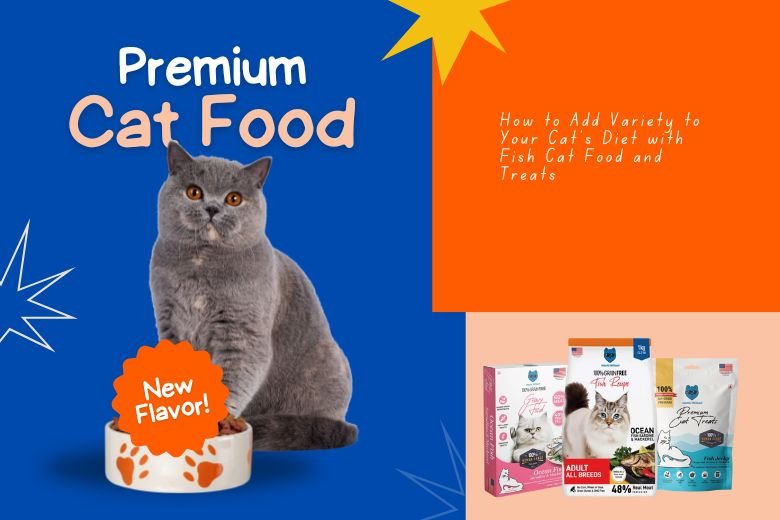Adding variety to your cat’s diet with fish cat food and treats can boost their nutrition and keep mealtime exciting. Learn safe, practical ways to incorporate fish-based options for a healthy, happy feline.
Introduction: Why Fish Could Be Your Cat’s New Favorite
Ever watched your cat’s eyes light up at the sound of a tuna can opening? Cats are naturally drawn to fish, and for good reason—it’s packed with nutrients they crave. Adding variety to your cat’s diet with fish cat food and treats not only keeps them engaged but also supports their health. Whether you’re a new cat parent or a seasoned one, learning how to safely introduce fish-based foods can make mealtimes both nutritious and fun. Let’s dive into how to add variety to your cat’s diet with fish cat food and treats while keeping their health first.
Why Variety in a Cat’s Diet Matters
Cats are obligate carnivores, meaning they need meat-based proteins to thrive. A varied diet prevents boredom and ensures they get a range of nutrients. Fish, rich in omega-3 fatty acids, supports skin, coat, and heart health. But too much of one food type can lead to imbalances, so mixing fish with other proteins is key.
- Prevents pickiness: Cats can become fussy if fed the same food daily.
- Nutritional balance: Fish offers unique nutrients like DHA and EPA.
- Mental stimulation: New flavors keep your cat curious and engaged.
Benefits of Fish Cat Food for Your Feline
Fish-based cat food, whether wet or dry, is a fantastic way to add variety to your cat’s diet with fish cat food and treats. It’s packed with protein and healthy fats that support overall wellness. For example, salmon and mackerel are high in omega-3s, which reduce inflammation and promote a shiny coat.
- Skin and coat health: Omega-3s reduce itching and flaking.
- Joint support: Fish oils can ease arthritis in older cats.
- Palatability: Cats love the taste, making it great for picky eaters.
Choosing the Right Fish Cat Food
Not all fish cat foods are created equal. Look for high-quality options with fish as the primary ingredient. Avoid foods with fillers like corn or soy, which offer little nutritional value. Here’s how to choose wisely:
- Check the label: Ensure fish (e.g., salmon, tuna) is listed first.
- Wet vs. dry: Wet food aids hydration, while dry food is convenient.
- Grain-free options: Ideal for cats with sensitivities.
Brands like Wellness CORE and Blue Buffalo offer fish-based formulas that meet AAFCO standards, ensuring complete nutrition.
Incorporating Fish Treats into Your Cat’s Diet
Fish cat treats are a fun way to add variety to your cat’s diet with fish cat food and treats. They’re perfect for training or bonding but should be given sparingly—treats should make up no more than 10% of your cat’s daily calories.
- Freeze-dried treats: High in protein, low in additives (e.g., PureBites).
- Soft treats: Great for older cats with dental issues.
- Portion control: Limit to 2–3 treats daily to avoid weight gain.
Try offering treats during playtime to keep your cat active and engaged.
How to Safely Introduce Fish to Your Cat’s Diet
Introducing fish cat food or treats requires a gradual approach to avoid digestive upset. Start by mixing a small amount of fish-based food with their current diet, increasing the ratio over 7–10 days. Watch for signs of allergies, like vomiting or skin irritation.
- Start small: Mix 25% fish food with 75% regular food.
- Monitor reactions: Look for changes in stool or behavior.
- Consult your vet: Especially for cats with medical conditions.
Best Types of Fish for Cats
Not all fish are safe or beneficial. Here’s a quick guide:
- Salmon: High in omega-3s, great for coat health.
- Tuna: A cat favorite, but limit due to mercury concerns.
- Whitefish: Lean and low in allergens.
- Avoid: Raw fish (can cause thiamine deficiency) or fish with added salt/spices.
Always choose cat-specific fish products over human-grade fish to ensure safety.
How Much Fish Is Too Much?
While fish is nutritious, overfeeding can lead to health issues. Mercury in fish like tuna can accumulate over time, and too much fish can cause nutrient imbalances. Aim for fish-based meals or treats 2–3 times a week, balanced with other proteins like chicken or beef.
- Moderation is key: Fish should not exceed 20–30% of their diet.
- Variety matters: Rotate with other protein sources.
Can Fish Cat Food Help Picky Eaters?
Yes! Fish’s strong aroma and flavor appeal to finicky felines. If your cat turns up their nose at other foods, try a fish-based wet food or treat to entice them. Gradually mix it with their regular food to transition them.
Homemade Fish Treats: A Fun Option
Making your own fish treats is a great way to add variety to your cat’s diet with fish cat food and treats. Try this simple recipe:
- Ingredients: 1 can of tuna (in water, drained), 1 egg, 1 cup whole wheat flour.
- Instructions: Blend ingredients, roll into small balls, bake at 350°F for 10–12 minutes.
- Storage: Keep in an airtight container for up to a week.
Always check with your vet before introducing homemade treats.
Common Mistakes to Avoid
- Overfeeding fish: Can lead to mercury buildup or obesity.
- Ignoring allergies: Some cats are sensitive to fish proteins.
- Low-quality products: Cheap foods may contain fillers or low-grade fish.
How to Add Variety to Your Cat’s Diet with Fish Cat Food and Treats – Frequently Asked Questions
Is fish cat food safe for daily feeding?
Fish cat food is safe in moderation but shouldn’t be the sole protein source. Rotate with other meats to ensure balanced nutrition. Learn more about choosing fish cat food.
Can kittens eat fish-based treats?
Kittens can have fish treats in small amounts, but their primary diet should be kitten-specific formulas for growth. Check with your vet first.
What’s the best fish for cats with allergies?
Whitefish or salmon are less likely to trigger allergies than tuna. Always introduce new foods slowly. See how to introduce fish safely.
How often should I give my cat fish treats?
Limit fish treats to 2–3 times per week, keeping them under 10% of daily calories. Read about incorporating treats.
Are homemade fish treats better than store-bought?
Homemade treats can be healthier if made with high-quality ingredients, but store-bought options are convenient and often fortified with nutrients. Try our recipe.
Conclusion
Adding variety to your cat’s diet with fish cat food and treats is a simple way to keep your feline healthy and excited about mealtime. By choosing high-quality products, introducing fish gradually, and balancing it with other proteins, you’ll support their nutrition and happiness. Have a tip for feeding fish to your cat? Share in the comments or explore our guides on cat nutrition basics or treating picky eaters.




